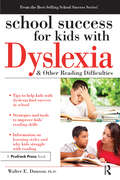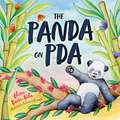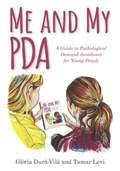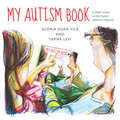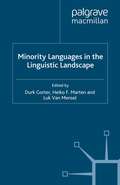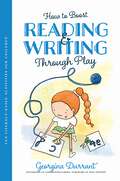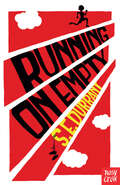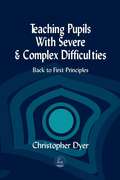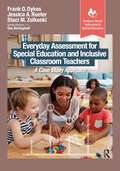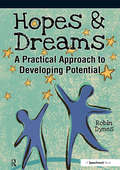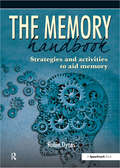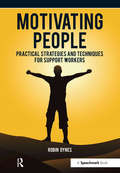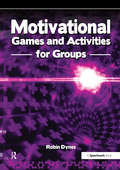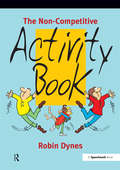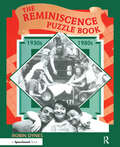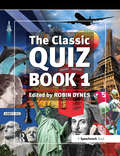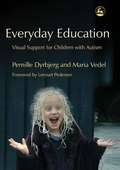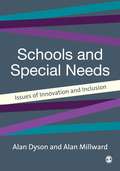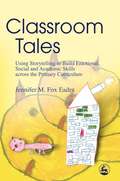- Table View
- List View
Ebook: Special Educational Needs, Inclusion and Diversity, 4e
by DunsmuirA textbook on special educational needs which offers a balance between theory, research and practice as well as a unique analysis of the implications of the effects of linguistic, cultural and ethnic diversity on special educational needs. The fourth edition of this textbook will be revised and updated in order to respond to changes in the field, including developments in national policy and in ways of thinking about special educational needs and inclusion. It will take account of research and publications that have appeared since 2014, in particular in the international literature. There will be more on the theoretical aspects of inclusive practice and some of the case studies and learning activities will be updated to make them as relevant as possible, reflecting contemporary examples of best practice in the field. In addition to the central cross-cutting theme (equality, diversity and inclusion), other themes incorporated across chapters will include professional ethics, parental support for learning, person-centred practices and the effects of poverty.
School Success for Kids With Dyslexia and Other Reading Difficulties
by Walter DunsonSchool Success for Kids With Dyslexia and Other Reading Difficulties provides parents and teachers with goals that will meet the needs of students who are struggling with reading, leading them to work through their difficulties and enjoy reading. It includes information, assessments, and techniques that parents, teachers, and school administrators can use immediately to foster reading success. Through an understanding of how English words are constructed, how the brain processes language, and the differences that exist between learning styles, parents and teachers will gain keen insight into the processes of reading, reading acquisition, and reading instruction. The book also covers topics such as how language skills can affect reading difficulties and how technology can be used to help students, and it provides a structured approach for parents to implement at home to help their struggling students find success.
School Success for Kids With Dyslexia and Other Reading Difficulties
by Walter DunsonSchool Success for Kids With Dyslexia and Other Reading Difficulties provides parents and teachers with goals that will meet the needs of students who are struggling with reading, leading them to work through their difficulties and enjoy reading. It includes information, assessments, and techniques that parents, teachers, and school administrators can use immediately to foster reading success. Through an understanding of how English words are constructed, how the brain processes language, and the differences that exist between learning styles, parents and teachers will gain keen insight into the processes of reading, reading acquisition, and reading instruction. The book also covers topics such as how language skills can affect reading difficulties and how technology can be used to help students, and it provides a structured approach for parents to implement at home to help their struggling students find success.
The Panda on PDA: A Children's Introduction to Pathological Demand Avoidance
by Glòria Durà-VilàIn this positive, gentle and PDA-friendly guide for young children, PDA is explained by a playful Panda who has PDA and is very proud of it. The Panda is full of talents and strengths, but finds it very hard to do what others want. In fact, the Panda has become great at climbing trees and bamboo, and hiding in caves to escape demands! The Panda addresses the challenges and struggles of PDA honestly, but can also thrive and live a happy life in the right environment, when supported by others.
Me and My PDA: A Guide to Pathological Demand Avoidance for Young People
by Glòria Durà-Vilà Tamar LeviThis beautifully illustrated guide helps young people with Pathological Demand Avoidance (PDA) to understand their diagnosis, develop self-awareness and implement their own personalised problem-solving strategies. Written in consultation with young people with PDA and their families, this book recognises the importance of handing control back to the young person, and that there is no one-size-fits-all PDA profile. Readers are encouraged to engage throughout with interactive writing, doodling and checklist exercises to explore their own particular characteristics, strengths and challenges.Me and My PDA is sensitively tailored to the needs and experiences of young people (aged 10+) with PDA. The guide is designed to grow with the reader, and can be used for many years as the young person develops and changes - making it invaluable to PDA-diagnosed individuals and their families.
My Autism Book: A Child's Guide to their Autism Spectrum Diagnosis (PDF)
by Glòria Durà-Vilà Tamar LeviMy Autism Book is a beautifully illustrated picture book that helps parents to explain an autism diagnosis to their child in a sensitive, positive and accurate way. When a child is diagnosed with an Autism Spectrum Disorder (ASD), parents often feel overwhelmed and uncertain about how to communicate the diagnosis to their child. This book is designed to be read with the child as a simple introduction to their diagnosis. Written by a doctor and a children's author, the book is tailored precisely to the needs and experiences of the child with ASD aged 5 and up. It explains what an autism diagnosis means and encourages an exploration of the child's likely strengths and differences using clear language that speaks directly to the child. The colourful pictures throughout show how the world looks from the child's perspective and the book ends with a summary checklist to encourage the child to record and discuss how autism affects them.
Minority Languages in the Linguistic Landscape (Palgrave Studies in Minority Languages and Communities)
by Durk Gorter, Heiko F. Marten, Luk Van MenselProviding an innovative approach to the written displays of minority languages in public space this volume explores minority language situations through the lens of linguistic landscape research. Based on very tangible data it explores the 'same old issues' of language contact and language conflict in new ways.
How to Boost Reading and Writing Through Play: Fun Literacy-Based Activities for Children
by Georgina DurrantEven if children know their phonics and ABC's inside out and can read every book in their book bag, why is it still so difficult to get them to want to read and write? How do we begin to get our children excited about literacy? The answer might surprise you...let them play!Featuring 40 engaging play-based activities, this book makes literacy so fun that children won't notice they're also actively developing reading and writing skills. From blow painting words to making paper chain sentences, each activity can be done using household items and they are adaptable for children of any age and ability, making learning accessible for all. With charming black and white line illustrations to depict each activity, this is a great way to connect with children while helping to build their literacy skills at the same time.
Running on Empty
by S.E. DurrantAJ's grandfather has always been the one to keep his unusual family together, so when he dies things start to unravel at the edges. AJ is worried about his parents but they don't really seem to notice. In order to deal with his grief and to keep his anxiety at bay, AJ does what he and his grandfather did best: running. Round and round the Olympic Park, aiming for the nationals, running to escape, AJ only seems to be heading ever closer to disaster. Running On Empty is a beautiful book about false starts and emotional journeys, with hope as the ultimate finishing line.
Teaching Pupils with Severe and Complex Difficulties: Back to First Principles (PDF)
by Christopher DyerShortlisted for Special Educational Needs Book Award 2001 In response to the growing demand for fully inclusive education, this book explores the principles that should guide teachers in meeting the educational needs of pupils with severe learning difficulties and relates these to effective classroom approaches. It examines the special needs of pupils with severe learning difficulties from the inside out, so that teachers understand the 'why' as well as the 'how' of education. It also examines issues of behaviour and punishment, offering positive and appropriate methods of dealing with classroom disruption. Christopher Dyer returns to first principles to show that the basics of teaching and education remain constant, no matter what the difficulties of the individual pupil might be, and that these basic principles are vital to planning IEPs (Individual Education Programmes). In an educational system increasingly made up of schemes, targets and progress reports, this book is a much-needed guide to finding and stimulating the learning potential of every child.
Everyday Assessment for Special Education and Inclusive Classroom Teachers: A Case Study Approach (Evidence-Based Instruction in Special Education)
by Frank Dykes Jessica Rueter Staci ZolkoskiEveryday Assessment for Special Education and Inclusive Classroom Teachers: A Case Study Approach provides a foundation in practical research-based methods to help today’s teachers tailor their instruction to meet the needs of all learners.With an easy-to-understand format, Everyday Assessment for Special Education and Inclusive Classroom Teachers combines real-life case studies with practitioner-friendly wording to teach and describe assessment topics in a concise manner. Practical applications for use in classroom settings can also be found throughout the text.What’s included in Everyday Assessment for Special Education and Inclusive Classroom Teachers: Example progress monitoring charts Curriculum-based assessments, behavior charts, and norm-referenced assessments to guide the reader when extracting data and inform everyday teaching practices Activities to practice skills and self-reflect on learning objectives at the end of each chapter Everyday Assessment for Special Education and Inclusive Classroom Teachers: A Case Study Approach pairs rationale and research with real-life case studies and applications for practice to prepare pre-service teachers to meet the unique needs of every learner.
Everyday Assessment for Special Education and Inclusive Classroom Teachers: A Case Study Approach (Evidence-Based Instruction in Special Education)
by Frank Dykes Jessica Rueter Staci ZolkoskiEveryday Assessment for Special Education and Inclusive Classroom Teachers: A Case Study Approach provides a foundation in practical research-based methods to help today’s teachers tailor their instruction to meet the needs of all learners.With an easy-to-understand format, Everyday Assessment for Special Education and Inclusive Classroom Teachers combines real-life case studies with practitioner-friendly wording to teach and describe assessment topics in a concise manner. Practical applications for use in classroom settings can also be found throughout the text.What’s included in Everyday Assessment for Special Education and Inclusive Classroom Teachers: Example progress monitoring charts Curriculum-based assessments, behavior charts, and norm-referenced assessments to guide the reader when extracting data and inform everyday teaching practices Activities to practice skills and self-reflect on learning objectives at the end of each chapter Everyday Assessment for Special Education and Inclusive Classroom Teachers: A Case Study Approach pairs rationale and research with real-life case studies and applications for practice to prepare pre-service teachers to meet the unique needs of every learner.
Hopes & Dreams - Developing Potential: A Practical Approach to Developing Potential
by Robin DynesThis practical resource provides the tools to help individuals explore their ambitions, set goals and plan to achieve them, manage their lives and gain the skills to make their hopes and dreams a reality. The programme is ideal for use with people who are making major changes in their lives and are ready to explore their options for the future. They may wish to return to education, go back to work, change jobs, start voluntary work, take up new interests or are considering other changes in their lives. The book is divided into two parts: six core sessions covering: Making a start, Deciding what you want, Setting goals, Making it happen, Learning to learn and What next? and Eight optional sessions. These can be used individually or added to the core sessions in any order, depending on identified need. The sessions cover: Dealing with stress, Coping with change, Being assertive, Overcoming relationship conflict, Organising your time, Dealing with disappointment, Keeping records and Creating an impression. It is an ideal resource for youth leaders, teachers, support workers, occupational therapists, social workers and probation staff. It has been developed through the experience of working with groups and individuals in adult education, youth services, day centres and rehabilitation centres.
The Memory Handbook: Strategies and Activities to Aid Memory
by Robin DynesThis is a handbook full of practical ideas to use with anyone who is experiencing mild to severe memory difficulties. The suggestions and activities can be used when working with individuals or groups. The strategies can, in fact, be used by anyone young or old, who has become worried about loss of memory. The handbook provides: information about how memory works and different types of memory; an outline of what can affect memory; strategies to aid memory; activities to practice using the strategies; and activities to keep the brain active and maintain memory. The resource is aimed at staff in care environments such as residential homes, day centres, social clubs, support groups, carers or anyone who might be concerned about loss of memory. It promotes understanding about memory difficulties and provides a wide range of strategies and activities to aid response to individual need. Approximately 200pp; A4 wire-o-bound.
The Memory Handbook: Strategies and Activities to Aid Memory
by Robin DynesThis is a handbook full of practical ideas to use with anyone who is experiencing mild to severe memory difficulties. The suggestions and activities can be used when working with individuals or groups. The strategies can, in fact, be used by anyone young or old, who has become worried about loss of memory. The handbook provides: information about how memory works and different types of memory; an outline of what can affect memory; strategies to aid memory; activities to practice using the strategies; and activities to keep the brain active and maintain memory. The resource is aimed at staff in care environments such as residential homes, day centres, social clubs, support groups, carers or anyone who might be concerned about loss of memory. It promotes understanding about memory difficulties and provides a wide range of strategies and activities to aid response to individual need. Approximately 200pp; A4 wire-o-bound.
Motivating People: Practical Strategies and Techniques for Support Workers
by Robin DynesIn all types of support services and care situations one of the biggest challenges is motivating people to change their behaviour. It particularly applies to individuals who are difficult to motivate because they might lack insight, wilfully ignore or refuse to face their situation, are affected by depression or health problems or are victims of unfortunate circumstances or fear of failure. The task may be to motivate someone to improve their quality of life by participating in a group in a residential home, change a lifestyle because of health reasons, address offending behaviour, learn a new skill to obtain a job or complete an anxiety management programme. The strategies and techniques will help: arouse their interest in making changes; encourage the consideration of change; support their planning for change; mentor the person through planned actions; ensure momentum is maintained; guide the person in making positive use of any relapses; and make sure the change is successfully achieved. This is an invaluable resource for support workers, social workers, health workers, youth workers, probation officers, employment services, tutors and carers. The techniques can be applied when working with individuals or groups in all types of settings including residential homes, day centres, probation, education or youth work.
Motivating People: Practical Strategies and Techniques for Support Workers
by Robin DynesIn all types of support services and care situations one of the biggest challenges is motivating people to change their behaviour. It particularly applies to individuals who are difficult to motivate because they might lack insight, wilfully ignore or refuse to face their situation, are affected by depression or health problems or are victims of unfortunate circumstances or fear of failure. The task may be to motivate someone to improve their quality of life by participating in a group in a residential home, change a lifestyle because of health reasons, address offending behaviour, learn a new skill to obtain a job or complete an anxiety management programme. The strategies and techniques will help: arouse their interest in making changes; encourage the consideration of change; support their planning for change; mentor the person through planned actions; ensure momentum is maintained; guide the person in making positive use of any relapses; and make sure the change is successfully achieved. This is an invaluable resource for support workers, social workers, health workers, youth workers, probation officers, employment services, tutors and carers. The techniques can be applied when working with individuals or groups in all types of settings including residential homes, day centres, probation, education or youth work.
Motivational Games and Activities for Groups: Exercises to Energise, Enthuse and Inspire
by Robin DynesHow can you encourage people to be motivated? How can you create that sense of yearning to achieve or reach a goal? How can you energise and inspire group members? The exercises and activities in this resource will help you to motivate your team or the group with which you are working. The activities are organised in sections from which you can choose to meet particular group needs. These include: Ice breakers and warm ups; Trust building; Building self-esteem; Inspiring creativity; Aligning values; Creating an inspiring environment; Becoming solution focused; Perception; Resilience; Team building; Visualising and setting goals; Energy boosters; Overcoming anxiety and fear; Managing stress; Stopping procrastination; and; Using competition. Whether your group is small or large you will find something for any setting. Many of the activities can also be used on a one-to-one basis in supervision, with clients or students. The activities are interactive and fun. Trainers, youth leaders, counsellors, group leaders, team managers, teachers, care workers and probation officers will find the resource one in which they constantly dip for inspiration. Robin Dynes is the Social Inclusion Officer for Skills & Learning in his local authority. His main role has been to develop an innovative outreach curriculum that is accessible and meets the needs of people with disabilities, older people and others who are vulnerable. The aim is to ensure that people with disabilities have equal opportunity and an active and fulfilling role within the community.
The Non-Competitive Activity Book
by Robin DynesThis superb practical handbook contains 100 activities that are non-competitive and can be used across the whole age spectrum with individuals or groups. It provides indispensable material for use with learning disabilities, mental health, physical disabilities and regressed psychiatric or geriatric patients. The non-competitive nature of these activities ensures that people feel safe in making a contribution, and fear of failure or disappointment is effectively eliminated. Divided into photocopiable sections, these provide a session format that focuses on maintaining and increasing the function of the whole person. It is an ideal resource for day centres, hospitals, care homes and the creative group leader.
The Reminiscence Puzzle Book: 1930s-1980s
by Robin DynesSpanning the years 1930 to 1989, this is a highly practical and enjoyable puzzle book. It covers events, people, entertainment and everyday life and is designed to encourage group participation to recall and discuss their own personal experiences. It is fully adaptable according to the needs and abilities of the individuals within the group.
The Reminiscence Puzzle Book: 1930s-1980s
by Robin DynesSpanning the years 1930 to 1989, this is a highly practical and enjoyable puzzle book. It covers events, people, entertainment and everyday life and is designed to encourage group participation to recall and discuss their own personal experiences. It is fully adaptable according to the needs and abilities of the individuals within the group.
Winslow Quiz Book: A Speechmark Social Activity Manual for Groups Book 1
by Robin DynesThis completely revised edition of Winslow's bestselling Quiz Book contains more than 2,000 questions categorised into 40 stimulating subjects. It is aimed at adolescents and adults alike and features questions that are all realistically within the scope of the average person. Designed for those who use quizzes as a group activity, the questions are grouped into three ability levels with a layout that enables the organiser to rapidly locate the required topic. Its topics cover areas such as cookery, animals, sport, home, spellings, history and general knowledge.
Everyday Education: Visual Support for Children with Autism
by Pernille Dyrbjerg Maria VedelVisual support aids can be highly effective tools for increasing levels of communication and independence in children with autism, who often have difficulty interpreting spoken language and non-verbal facial expressions. Fully illustrated with inspiring examples, Everyday Education provides a wealth of ideas for creating visual support aids for children on the autism spectrum. Photographs and clear, practical explanations describe how these tools can be arranged helpfully around the home for the child to use. The authors describe how visual support aids can be used in all kinds of everyday situations, from labelling - for example, sticking a picture of a dinner plate with a knife and fork to the chair in which the child sits at meal times - to putting together a pictorial activities schedule for the child to refer to. This fun and encouraging book will be a valuable source of ideas for parents of children with autism and professionals working with them.
Schools and Special Needs: Issues of Innovation and Inclusion (PDF)
by Alan Dyson Dr Alan MillwardShortlisted for the Standing Conference on Studies in Education (SCSE) book awards for 2001 In Schools and Special Needs, the authors provide a critical perspective on the dominant `inclusion' model of special needs education, in terms of implementation in schools and effectiveness of pupil learning outcomes. They take issue with the major advocates of the inclusion model and argue that a different way of understanding special educational needs in mainstream schools is both possible and necessary. The authors, who are eminent in the special needs field, use up-to-date material to develop a new model for special- education in schools.
Classroom Tales: Using Storytelling to Build Emotional, Social and Academic Skills across the Primary Curriculum
by Jennifer EadesStories and storytelling help children to develop emotional literacy, make sense of their world and appreciate different points of view. Fox Eades shows how storytelling is a crucial element of children's education that can enrich the school curriculum and encourage social and thinking skills. The author discusses the different kinds of story that are useful in the classroom context, including traditional stories, fairy tales and sacred stories, and explores the impact of individual and group dynamics on the telling and reception of these stories. She also considers recognised therapeutic uses of storytelling. She provides a series of sample stories and gives practical tips on adapting these to suit different situations and meet different needs. She also advises on a range of techniques such as using props, allowing `reflection' time and prompting interaction. Sections on collective stories and the child as storyteller explain how children can be inspired to compose their own tales that offer opportunities to practise self-expression and negotiation. This practical and engaging book provides all the tools and techniques needed to use storytelling effectively, and will be an essential resource for primary school teachers and others working with children in educational contexts, social workers and parents.

